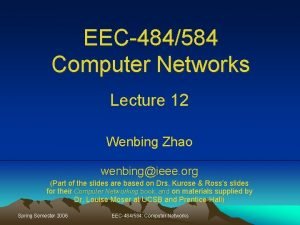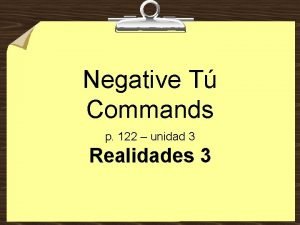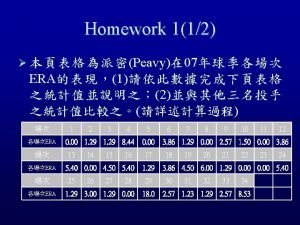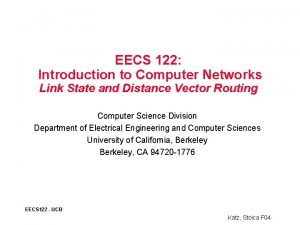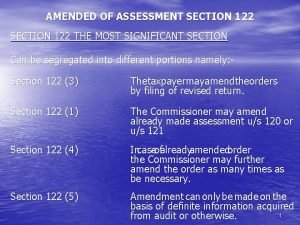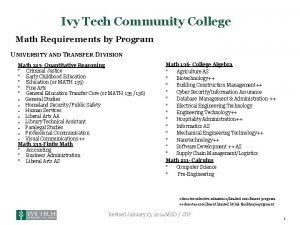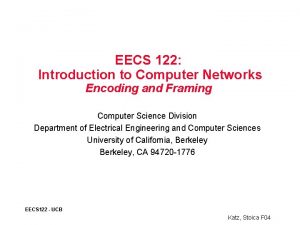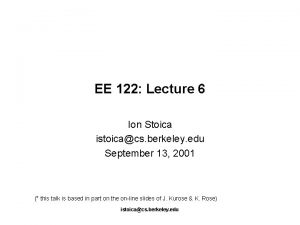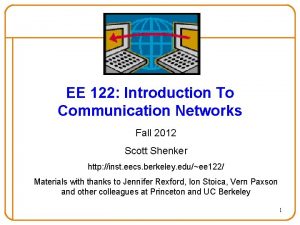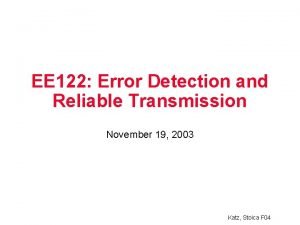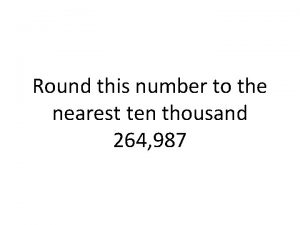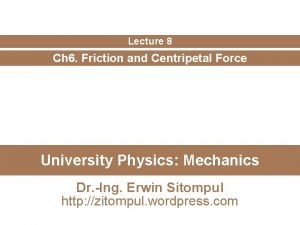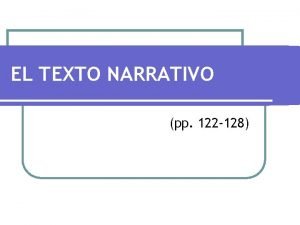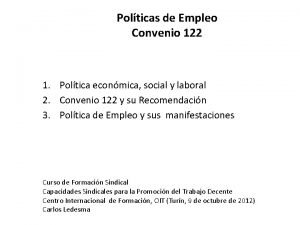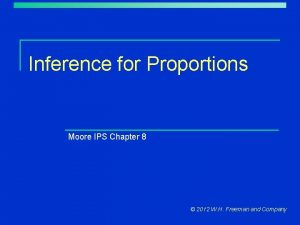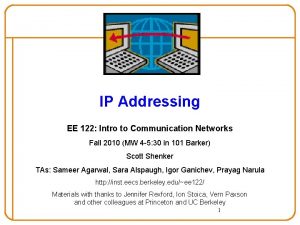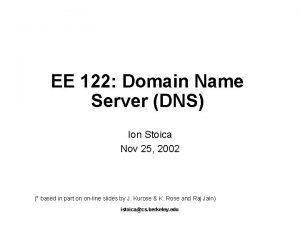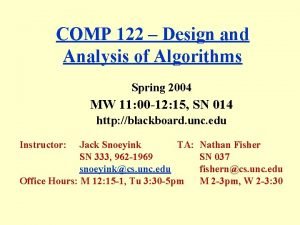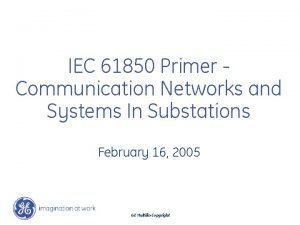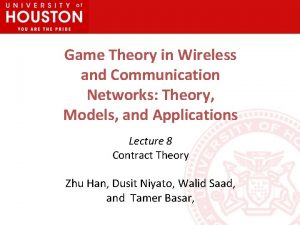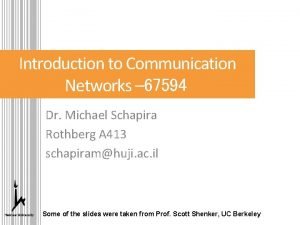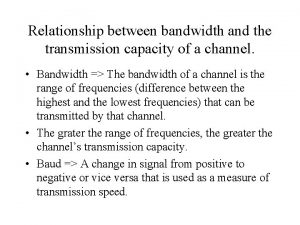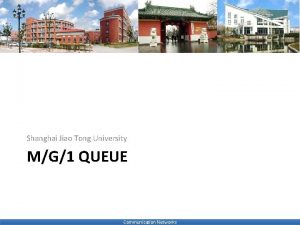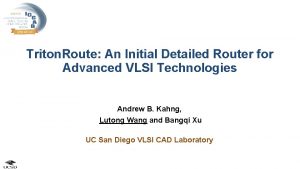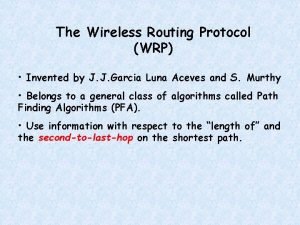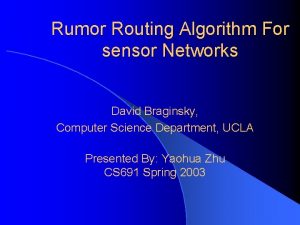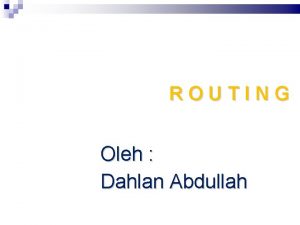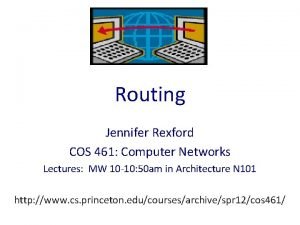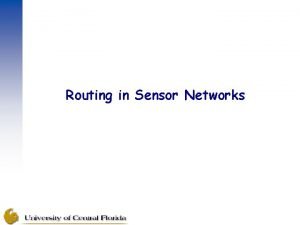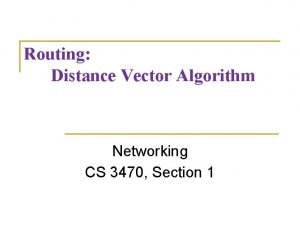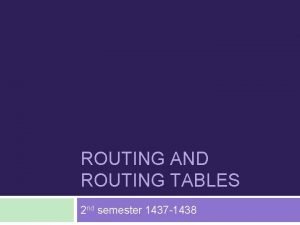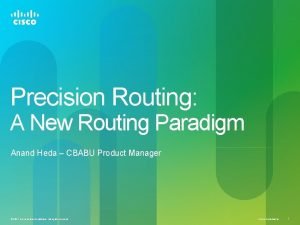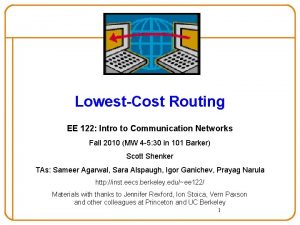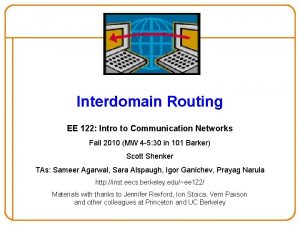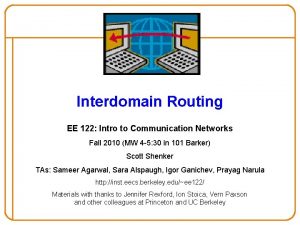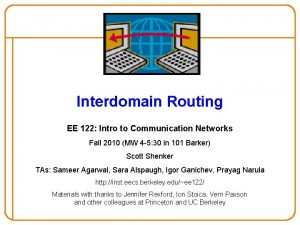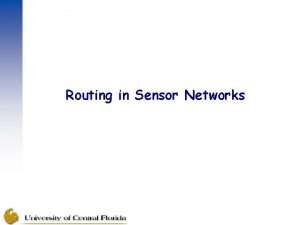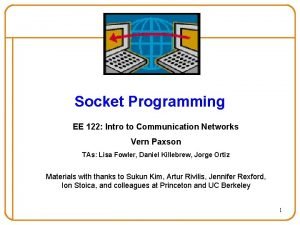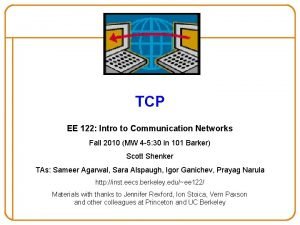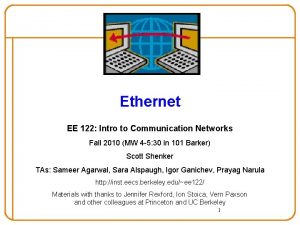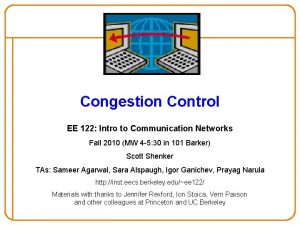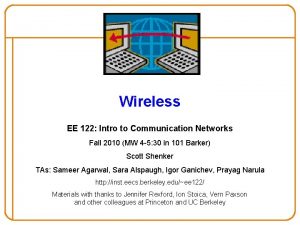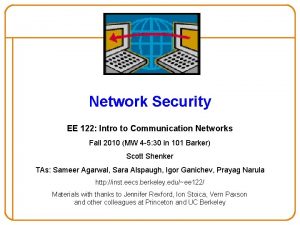LowestCost Routing EE 122 Intro to Communication Networks

































































- Slides: 65

Lowest-Cost Routing EE 122: Intro to Communication Networks Fall 2010 (MW 4 -5: 30 in 101 Barker) Scott Shenker TAs: Sameer Agarwal, Sara Alspaugh, Igor Ganichev, Prayag Narula http: //inst. eecs. berkeley. edu/~ee 122/ Materials with thanks to Jennifer Rexford, Ion Stoica, Vern Paxson and other colleagues at Princeton and UC Berkeley 1

Announcements • Revision to lecture schedule – Advanced topics on routing • Revision to homework schedule – 3 a: get midterm questions right – 3 b: new topics • Changes to class structure – 5 minute “technology break” – Administrivia right after break – Group problem solving (when possible) o Sit next to smart people 2

Goals of Today’s Lecture • Routing overview: – Routing vs. forwarding – Routing topics • Link-state routing (Dijkstra’s algorithm) • Distance-vector routing (Bellman-Ford) 3

Forwarding vs. Routing • Forwarding: “data plane” –Directing a data packet to an outgoing link –Individual router using a forwarding table • Routing: “control plane” –Computing paths the packets will follow –Routers talking amongst themselves –Jointly creating a forwarding table 4

Why Does Routing Matter? • Routing provides connectivity! – Without routing, the network doesn’t function • Routing finds “good” paths – Propagation delay, throughput, packet loss • Routing allows network to tolerate failures – Limits packet loss during disruptions • Routing can also provide “Traffic Engineering” – Balance traffic over the routers and links – Avoid congestion by directing traffic to lightly-loaded links – (Not covered today) 5

Three Lectures on Routing • Today: Lowest-cost routing – Simple algorithms, basic issues • Wednesday: Policy-based routing – Interdomain routing • Monday: Advanced topics – Traffic engineering – Improved resilience – What future routing algorithms might look like…. 6

Routing Requires Knowing Network • Centralized global state – Single entity knows the complete network structure – Can calculate all routes centrally Link State Routing – Problems with this approach? E. g. Algorithm: Dijkstra • Distributed global state E. g. Protocol: OSPF – Every router knows the complete network structure – Independently calculates routes Distance Vector Routing – Problems with this approach? • Distributed global E. g. Algorithm: Bellman-Ford E. g. Protocol: RIP computation – Every router knows only about its neighboring routers – Participates in global joint calculation of routes – Problems with this approach? 7

Modeling a Network • Modeled as a graph – Routers nodes – Link edges o Possible edge costs • Hop • Delay • Congestion level • …. 5 2 A 3 B 2 3 1 D C 1 5 F 1 E 2 • Goal of Routing – Determine “good” path from source to destination – “Good” usually means the lowest “cost” path – Where cost is usually hop-count or latency 8

From Model to Reality • In reality, attach prefixes to nodes • Calculate routing tables in terms of prefixes • But ignore this for now…. . – Just calculate paths between routers 9

Why Isn’t All Routing Lowest-Cost? • Lowest-cost routing assumes all nodes evaluate paths the same way – i. e. , use same “cost” metric • Interdomain routing: – Different domains care about different things – Can exercise general “policy” goals • Requires very different route computation – Talk about on Wednesday…. 10

Link State Routing • Each router has complete network picture – Topology – Link costs • How does each router get the global state? – Each router reliably floods information about its neighbors to every other router (more later) • Each router independently calculates the shortest path from itself to every other router – Using, for example, Dijkstra’s Algorithm 11

Link State: Control Traffic • Each node floods its local information • Each node ends up knowing the entire network topology node Host C Host D Host A N 2 N 1 N 3 N 5 Host B Host E N 4 N 6 12 N 7

Link State: Node State C A Host C D A C D D Host D B B E B N 2 N 1 A E E C D N 3 A C D B Host B N 5 E B E A A D B 13 B D C N 4 N 6 C E N 7 Host E E

Dijkstra’s Shortest Path Algorithm • INPUT: – Network topology (graph), with link costs • OUTPUT: – Least cost paths from one node to all other nodes – Produces “tree” of routes (why? ) 14

Notation • c(i, j): link cost from node i to j; cost infinite if not direct neighbors; ≥ 0 • D(v): current value of cost 5 of path from source to destination v • p(v): predecessor node along path from source to v, that is next to v 2 A B 2 1 D • S: set of nodes whose 3 C 3 1 5 F 1 E 2 least cost path definitively known Source 15

Dijsktra’s Algorithm • c(i, j): link cost from node i to j 1 Initialization: • D(v): current cost source v 2 S = {A}; 3 for all nodes v • p(v): predecessor node along 4 if v adjacent to A path from source to v, that is 5 then D(v) = c(A, v); next to v 6 else D(v) = ; • S: set of nodes whose least cost 7 path definitively known 8 Loop 9 find w not in S such that D(w) is a minimum; 10 add w to S; 11 update D(v) for all v adjacent to w and not in S: 12 if D(w) + c(w, v) < D(v) then // w gives us a shorter path to v than we’ve found so far 13 D(v) = D(w) + c(w, v); p(v) = w; 14 until all nodes in S; 16

Example: Dijkstra’s Algorithm Step 0 1 2 3 4 5 D(B), p(B) D(C), p(C) D(D), p(D) 2, A 1, A 5, A start S A 5 2 A B 2 1 D 3 C 3 1 5 F 1 E 2 D(E), p(E) D(F), p(F) 1 Initialization: 2 S = {A}; 3 for all nodes v 4 if v adjacent to A 5 then D(v) = c(A, v); 6 else D(v) = ; … 17

Example: Dijkstra’s Algorithm Step 0 1 2 3 4 5 D(B), p(B) D(C), p(C) D(D), p(D) 2, A 1, A 5, A start S A 5 2 A B 2 1 D 3 C 3 1 5 F 1 E 2 D(E), p(E) D(F), p(F) … 8 Loop 9 find w not in S s. t. D(w) is a minimum; 10 add w to S; 11 update D(v) for all v adjacent to w and not in S: • If D(w) + c(w, v) < D(v) then • D(v) = D(w) + c(w, v); p(v) = w; 14 until all nodes in S; 18

Example: Dijkstra’s Algorithm Step 0 1 2 3 4 5 D(B), p(B) D(C), p(C) D(D), p(D) 2, A 1, A 5, A start S A AD 5 2 A B 2 1 D 3 C 3 1 5 F 1 E 2 D(E), p(E) D(F), p(F) … 8 Loop 9 find w not in S s. t. D(w) is a minimum; 10 add w to S; 11 update D(v) for all v adjacent to w and not in S: • If D(w) + c(w, v) < D(v) then • D(v) = D(w) + c(w, v); p(v) = w; 14 until all nodes in S; 19

Example: Dijkstra’s Algorithm Step 0 1 2 3 4 5 D(B), p(B) D(C), p(C) D(D), p(D) 2, A 1, A 5, A 4, D start S A AD 5 2 A B 2 1 D 3 C 3 1 5 F 1 E 2 D(E), p(E) D(F), p(F) 2, D … 8 Loop 9 find w not in S s. t. D(w) is a minimum; 10 add w to S; 11 update D(v) for all v adjacent to w and not in S: • If D(w) + c(w, v) < D(v) then • D(v) = D(w) + c(w, v); p(v) = w; 14 until all nodes in S; 20

Example: Dijkstra’s Algorithm Step 0 1 2 3 4 5 D(B), p(B) D(C), p(C) D(D), p(D) D(E), p(E) D(F), p(F) 2, A 1, A 5, A 4, D 2, D 3, E 4, E start S A AD ADE 5 2 A B 2 1 D 3 C 3 1 5 F 1 E 2 … 8 Loop 9 find w not in S s. t. D(w) is a minimum; 10 add w to S; 11 update D(v) for all v adjacent to w and not in S: • If D(w) + c(w, v) < D(v) then • D(v) = D(w) + c(w, v); p(v) = w; 14 until all nodes in S; 21

Example: Dijkstra’s Algorithm Step 0 1 2 3 4 5 D(B), p(B) D(C), p(C) D(D), p(D) 2, A 1, A 5, A 4, D 3, E start S A AD ADEB 5 2 A B 2 1 D 3 C 3 1 5 F 1 E 2 D(E), p(E) D(F), p(F) 2, D 4, E … 8 Loop 9 find w not in S s. t. D(w) is a minimum; 10 add w to S; 11 update D(v) for all v adjacent to w and not in S: • If D(w) + c(w, v) < D(v) then • D(v) = D(w) + c(w, v); p(v) = w; 14 until all nodes in S; 22

Example: Dijkstra’s Algorithm Step 0 1 2 3 4 5 D(B), p(B) D(C), p(C) D(D), p(D) 2, A 1, A 5, A 4, D 3, E start S A AD ADEBC 5 2 A B 2 1 D 3 C 3 1 5 F 1 E 2 D(E), p(E) D(F), p(F) 2, D 4, E … 8 Loop 9 find w not in S s. t. D(w) is a minimum; 10 add w to S; 11 update D(v) for all v adjacent to w and not in S: • If D(w) + c(w, v) < D(v) then • D(v) = D(w) + c(w, v); p(v) = w; 14 until all nodes in S; 23

Example: Dijkstra’s Algorithm Step 0 1 2 3 4 5 D(B), p(B) D(C), p(C) D(D), p(D) 2, A 1, A 5, A 4, D 3, E start S A AD ADEBCF 5 2 A B 2 1 D 3 C 3 1 5 F 1 E 2 D(E), p(E) D(F), p(F) 2, D 4, E … 8 Loop 9 find w not in S s. t. D(w) is a minimum; 10 add w to S; 11 update D(v) for all v adjacent to w and not in S: • If D(w) + c(w, v) < D(v) then • D(v) = D(w) + c(w, v); p(v) = w; 14 until all nodes in S; 24

Example: Dijkstra’s Algorithm Step 0 1 2 3 4 5 D(B), p(B) D(C), p(C) D(D), p(D) 2, A 1, A 5, A 4, D 3, E start S A AD ADEBCF 5 2 A B 2 1 D 3 C 3 1 2, D 4, E To determine path A C (say), work backward from C via p(v) 5 F 1 E D(E), p(E) D(F), p(F) 2 25

The Forwarding Table • Running Dijkstra at node A gives the shortest path from A to all destinations� • We then construct the forwarding table 5 2 A B 2 1 D 3 C 3 1 5 F 1 E 2 Destination Link B (A, B) C (A, D) D (A, D) E (A, D) F (A, D) 26

Complexity • How much processing does running the Dijkstra algorithm take? • Assume a network consisting of N nodes – Each iteration: check all nodes w not in S – N(N+1)/2 comparisons: O(N 2) – More efficient implementations: O(N log(N)) 27

Obtaining Global State • Flooding – Each router sends link-state information out its links – The next node sends it out through all of its links o except the one where the information arrived o Note: need to remember previous msgs & suppress duplicates! X A C B D X A C B (a) X A C B (c) D (b) D X A C B (d) D 28

Flooding the Link State • Reliable flooding – Ensure all nodes receive link-state information – Ensure all nodes use the latest version • Challenges – Packet loss – Out-of-order arrival • Solutions – Acknowledgments and retransmissions – Sequence numbers 29

When to Initiate Flooding • Topology change – Link or node failure – Link or node recovery • Configuration change – Link cost change – Potential problems with making cost dynamic! • Periodically – Refresh the link-state information – Typically (say) 30 minutes – Corrects for possible corruption of the data 30

Oscillating Load-Dependent Routing • Assume link cost = amount of carried traffic – All traffic sent to A 1+e D 0 0 B e 0 C 1 1 e initially 2+e A 0 D 1+e 1 B 0 0 C A 0 2+e D 0 0 B 1 1+e C … recompute routing 0 D … recompute A 0 0 0 B Very Hard to Avoid. COscillations! 31 2+e A 0 D 1+e 1 B e 0 C … recompute

Detecting Topology Changes • Beaconing – Periodic “hello” messages in both directions – Detect a failure after a few missed “hellos” “hello” • Performance trade-offs – Detection speed – Overhead on link bandwidth and CPU – Likelihood of false detection 32

Convergence • Getting consistent routing information to all nodes – E. g. , all nodes having the same link-state database • Consistent forwarding after convergence – All nodes have the same link-state database – All nodes forward packets on shortest paths – The next router on the path forwards to the next hop 33

Convergence Delay • Time elapsed before every router has a consistent picture of the network • Sources of convergence delay – Detection latency – Flooding of link-state information – Recomputation of forwarding tables • Performance during convergence period – Lost packets due to blackholes and TTL expiry – Looping packets consuming resources – Out-of-order packets reaching the destination • Very bad for Vo. IP, online gaming, and video 34

Reducing Convergence Delay • Faster detection – Smaller hello timers – Link-layer technologies that can detect failures • Faster flooding – Flooding immediately – Sending link-state packets with high-priority • Faster computation – Faster processors on the routers – Incremental Dijkstra algorithm • Faster forwarding-table update – Data structures supporting incremental updates 35

Transient Disruptions • Inconsistent link-state database – Some routers know about failure before others – The shortest paths are no longer consistent – Can cause transient forwarding loops B C A B A F D E A and D think that this is the path to C C Loop! F D E E thinks that this is the path to C 36

Scaling Link-State Routing • Overhead of link-state routing – Flooding link-state packets throughout the network – Running Dijkstra’s shortest-path algorithm – Becomes unscalable when 100 s of routers • Introducing hierarchy through “areas” Area 2 Area 1 area border router Area 0 Area 3 Area 4 37

Link-State Routing Is Conceptually Simple • Each router keeps track of its incident links – Link cost, and whether the link is up or down • Each router broadcasts the link state – To give every router a complete view of the graph • Each router runs Dijkstra’s algorithm – Compute shortest paths, then construct forwarding table • Example protocols – Open Shortest Path First (OSPF) – Intermediate System (IS-IS) • Challenges: scaling, transient disruptions – Any ideas for improvement? 38

Question • Why use different routing algorithms at L 2 and L 3? – Is Link-State “plug-and-play”? – Could we make it “plug-and-play? ” 39

5 Minute Break Questions Before We Proceed? 40

Feedback on Course • Course moving: – Too slowly: – Too quickly: – OK: • Include History/Politics: 13% 30% 57% • Lectures should be: – Harder: – Easier: – Same: 18% 26% 56% • Homework should be: – Harder: – Easier: – Same: 33% 13% 54% – Yes: 76% • Include worked ex’s: – Yes: 82% • Project is: – Too easy: – Too hard: – OK: 11% 33% 56% • Support in Section – Yes: – Don’t go: 80% 12% 41

Selected Comments • Use newsgroups • Weekly homeworks • Relate project to course • Don't skip break • Test too easy • Bspace is evil • “Cancel the project and final, buy us dinner” • “Make lectures less boring” 42

More Scalable Routing Algorithms? • Avoid need for global state consistency • Just focus on computing routes • Distribute the computation, not the state…. 43

Distance Vector Routing • Each router knows the links to its neighbors – Does not flood this information to the whole network • Each router has provisional “shortest path” – E. g. : Router A: “I can get to router B with cost 11 via next hop router D” • Routers exchange this information with their neighboring routers – Again, no flooding the whole network • Routers update their idea of the best path using info from neighbors • This iterative process converges with set of shortest paths 44

Information Flow in Distance Vector Host C Host D Host A N 1 N 2 N 3 N 5 Host B Host E N 4 N 6 N 7 45

Information Flow in Distance Vector Host C Host D Host A N 1 N 2 N 3 N 5 Host B Host E N 4 N 6 N 7 46

Information Flow in Distance Vector Host C Host D Host A N 1 N 2 N 3 N 5 Host B Host E N 4 N 6 N 7 47

Why Is This Different From Flooding? 48

Bellman-Ford Algorithm • INPUT: – Link costs to each neighbor – Not full topology • OUTPUT: – Next hop to each destination and the corresponding cost – Does not give the complete path to the destination 49

Bellman-Ford - Overview • Each router maintains a table Each node: – Row for each possible destination – Column for each directly-attached neighbor to node wait for (change in local link – Entry in row Y and column Z of node X cost or msg from neighbor) best known distance from X to Y, via Z as next hop = DZ(X, Y) • Each local iteration caused by: – Local link cost change – Message from neighbor • Notify neighbors only if least cost path to any destination changes – Neighbors then notify their neighbors if necessary recompute distance table if least cost path to any dest has changed, notify neighbors 50

Bellman-Ford - Overview • Each router maintains a table – Row for each possible destination – Column for each directly-attached neighbor to node – Entry in row Y and column Z of node X best known distance from X to Y, via Z as next hop = DZ(X, Y) Neighbor (next-hop) Node A 2 A B 7 3 1 C D 1 B C B 2 8 C 3 7 D 4 8 Destinations DC(A, D)

Bellman-Ford - Overview • Each router maintains a table – Row for each possible destination – Column for each directly-attached neighbor to node – Entry in row Y and column Z of node X best known distance from X to Y, via Z as next hop = DZ(X, Y) Node A 2 A B 7 3 1 C D 1 B C B 2 8 C 3 7 D 4 8 Smallest distance in row Y = shortest Distance of A to Y, D(A, Y)

Distance Vector Algorithm (cont’d) 1 Initialization: 2 for all neighbors V do • c(i, j): link cost from node i to j 3 if V adjacent to A • DZ(A, V): cost from A to V via Z 4 D(A, V) = c(A, V); • D(A, V): cost of A’s best path to V • else • D(A, V) = ∞; • send D(A, Y) to all neighbors loop: 8 wait (until A sees a link cost change to neighbor V /* case 1 */ 9 or until A receives update from neighbor V) /* case 2 */ 10 if (c(A, V) changes by ±d) /* case 1 */ 11 for all destinations Y that go through V do 12 DV(A, Y) = DV(A, Y) ± d 13 else if (update D(V, Y) received from V) /* case 2 */ /* shortest path from V to some Y has changed */ 14 DV(A, Y) = DV(A, V) + D(V, Y); /* may also change D(A, Y) */ 15 if (there is a new minimum for destination Y) 16 send D(A, Y) to all neighbors 53 17 forever

Example: 1 st Iteration (C A) Node A 2 A B 7 3 1 C D 1 Node B A C D B C B 2 8 A C ∞ 7 C ∞ 1 ∞ D ∞ 8 D ∞ ∞ 3 2 ∞ ∞ DC(A, B) = DC(A, C) + D(C, B) = 7 + 1 = 8 DC(A, D) = DC(A, C) + D(C, D) = 7 + 1 = 8 7 Node C loop: … 13 else if (update D(A, Y) from C) A 14 DC(A, Y) = DC(A, C) + D(C, Y); 7 15 if (new min. for destination Y)B D 8 16 send D(A, Y) to all neighbors 9 17 forever Node D A 7 B ∞ D B C ∞ A ∞ ∞ ∞ 1 ∞ B 3 ∞ ∞ ∞ 1 C ∞ 1

Example: 1 st Iteration (B A) Node A 2 A B 7 3 1 C D 1 Node B A C D B C B 2 8 A C 3 7 C ∞ 1 ∞ D 5 8 D ∞ ∞ 3 2 ∞ ∞ DB(A, C) = DB(A, B) + D(B, C) = 2 + 1 = 3 DB(A, D) = DB(A, B) + D(B, D) = 2 + 3 = 5 7 Node C loop: … 13 else if (update D(A, Y) from B) A 14 DB(A, Y) = DB(A, B) + D(B, Y); 7 15 if (new min. for destination Y)B D 8 16 send D(A, Y) to all neighbors 9 17 forever Node D A 7 B ∞ ∞ 1 ∞ ∞ D ∞ 1 B C A ∞ ∞ B 3 ∞ C ∞ 1

Example: End of 1 st Iteration Node A 2 A B 7 3 1 C D 1 Node B A C D A 2 3 ∞ 7 C 9 1 4 8 D ∞ 2 3 B C B 2 8 C 3 D 5 Node C End of 1 st Iteration All nodes knows the best two-hop paths Node D A B D A 7 3 ∞ A 5 8 B 9 1 4 B 3 2 D ∞ 4 1 C 4 1

Example: 2 nd Iteration (A B) Node A 2 A B 7 3 1 C D 1 Node B A C D A 2 3 ∞ 7 C 5 1 4 8 D 7 2 3 B C B 2 8 C 3 D 5 DA(B, C) = DA(B, A) + D(A, C) = 2 + 3 = 5 DA(B, D) = DA(B, A) + D(A, D) = 2 + 5 = 7 7 Node C loop: … 13 else if (update D(B, Y) from A) A 14 DA(B, Y) = DA(B, A) + D(A, Y); 7 15 if (new min. for destination Y)B D 8 16 send D(B, Y) to all neighbors 9 17 forever Node D A B D B C 7 3 ∞ A 5 8 9 1 4 B 3 2 ∞ 4 1 C 4 1

Example: End of 2 nd Iteration Node A 2 A B 7 3 1 C D 1 Node B A C D A 2 3 11 7 C 5 1 4 8 D 7 2 3 B C B 2 8 C 3 D 4 Node C End of 2 nd Iteration All nodes knows the best three-hop paths Node D A B D A 7 3 6 A 5 4 B 9 1 4 B 3 2 D 12 4 1 C 4 1

Example: End of 3 rd Iteration Node A 2 A B 7 3 1 C D 1 Node B A C D A 2 3 6 7 C 5 1 4 8 D 7 2 3 B C B 2 8 C 3 D 4 Node C End of 2 nd Iteration: Algorithm Converges! Node D A B D A 7 3 5 A 5 4 B 9 1 4 B 3 2 D 11 4 1 C 4 1

Distance Vector: Link Cost Changes loop: 8 wait (until A sees a link cost change to neighbor V 9 or until A receives update from neighbor V) / 10 if (c(A, V) changes by ±d) /* case 1 */ 11 for all destinations Y that go through V do 12 DV(A, Y) = DV(A, Y) ± d 13 else if (update D(V, Y) received from V) /* case 2 */ 14 DV(A, Y) = DV(A, V) + D(V, Y); 15 if (there is a new minimum for destination Y) 16 send D(A, Y) to all neighbors 17 forever A Node B Node C C A C 1 6 9 1 1 B 4 A 1 50 A C A 1 3 C 3 1 A 4 6 A 1 6 A C 9 1 C A B A B A 50 5 A 50 2 B 54 1 B 51 1 Link cost changes here C 60 time Algorithm terminates “good news travels fast”

DV: Count to Infinity Problem loop: 8 wait (until A sees a link cost change to neighbor V 9 or until A receives update from neighbor V) / 10 if (c(A, V) changes by ±d) /* case 1 */ 11 for all destinations Y that go through V do 12 DV(A, Y) = DV(A, Y) ± d 13 else if (update D(V, Y) received from V) /* case 2 */ 14 DV(A, Y) = DV(A, V) + D(V, Y); 15 if (there is a new minimum for destination Y) 16 send D(A, Y) to all neighbors 17 forever A C A 4 6 A 60 6 C 9 1 A B A 50 5 A B 54 1 Node B Node C Link cost changes here 60 4 A A C A 60 6 C 9 1 A B 50 7 A B 101 1 1 50 A C A 60 8 C 9 1 A B 50 7 B 101 1 61 B C “bad news travels … slowly” time

Distance Vector: Poisoned Reverse • If B routes through C to get to A: 60 4 - B tells C its (B’s) distance to A is infinite (so C won’t route to A via B) - Will this completely solve count to infinity problem? A C A 4 6 A 60 6 C 9 1 A B A 50 5 B 1 Node B Node C ∞ ∞ A C A 60 6 C 9 1 A B A 50 ∞ B ∞ 1 A 1 C 50 A C A 60 51 C 9 1 A B A 50 ∞ B ∞ 1 Link cost changes here; C updates D(C, A) = 60 as B has advertised D(B, A) = ∞ B A C A 60 51 C 9 1 A B A 50 ∞ B ∞ 1 time Algorithm terminates 62

Routing Information Protocol (RIP) • Simple distance-vector protocol – Nodes send distance vectors every 30 seconds – … or, when an update causes a change in routing • Link costs in RIP – All links have cost 1 – Valid distances of 1 through 15 – … with 16 representing infinity – Small “infinity” smaller “counting to infinity” problem • RIP is limited to fairly small networks – E. g. , campus 63

Question • Can we solve the count-to-infinity problem? • Do we need to solve the count-to-infinity problem? 64

Summary • Routing is a distributed algorithm – Different from forwarding – React to changes in the topology – Compute the shortest paths • Two main shortest-path algorithms – Dijkstra link-state routing (e. g. , OSPF, IS-IS) – Bellman-Ford distance-vector routing (e. g. , RIP) • Convergence process – Changing from one topology to another – Transient periods of inconsistency across routers • Next time: BGP – Reading: K&R 4. 6. 3 65
 Reservoir flood routing worked examples
Reservoir flood routing worked examples Mark tinka
Mark tinka Continuity equation hydrology
Continuity equation hydrology Clock and power routing in vlsi
Clock and power routing in vlsi Badrinath
Badrinath Broadcast routing in computer networks
Broadcast routing in computer networks Virtual circuit vs datagram
Virtual circuit vs datagram Basestore iptv
Basestore iptv 8dar8
8dar8 Nec 250-94
Nec 250-94 Hyponomy
Hyponomy Homework 122
Homework 122 Eecs 122
Eecs 122 Ece 122
Ece 122 Section 122(9)
Section 122(9) Ivy tech math 135
Ivy tech math 135 Eecs 122
Eecs 122 Nec 250 122
Nec 250 122 Psalm 25 passion translation
Psalm 25 passion translation Tehillim 122
Tehillim 122 Ion stoica berkeley
Ion stoica berkeley Ee 122
Ee 122 Ee 122
Ee 122 W-122 airspace
W-122 airspace Psalm 122 tpt
Psalm 122 tpt 50000/122
50000/122 Hist 122
Hist 122 What is 757 rounded to the nearest ten
What is 757 rounded to the nearest ten Psalm 24:5-6
Psalm 24:5-6 Nrs 122
Nrs 122 A traffic light weighing 122 n hangs from a cable
A traffic light weighing 122 n hangs from a cable 건설업 gdp 비중
건설업 gdp 비중 Texto en 3ra persona
Texto en 3ra persona Convenio 122 oit
Convenio 122 oit You buy a package of 122 smarties
You buy a package of 122 smarties Ece 122
Ece 122 Ee 122
Ee 122 Art 119 lottt
Art 119 lottt Psalm 122:1-9
Psalm 122:1-9 Harga 3 lusin pensil 45 harga 32 pensil tersebut adalah
Harga 3 lusin pensil 45 harga 32 pensil tersebut adalah In ip addressing, an address beginning with 122 is
In ip addressing, an address beginning with 122 is Frc pneumatics
Frc pneumatics Ee 122
Ee 122 Comp122
Comp122 Iec 61850 communication networks and systems in substations
Iec 61850 communication networks and systems in substations Game theory in wireless and communication networks
Game theory in wireless and communication networks Introduction to communication networks
Introduction to communication networks Networks of communication and exchange
Networks of communication and exchange A communication processor that connects dissimilar networks
A communication processor that connects dissimilar networks Industrial communication networks
Industrial communication networks Pollaczek khinchin formula
Pollaczek khinchin formula Routing direction
Routing direction Routing table
Routing table Mppc adalah
Mppc adalah Sd-wan segmentation
Sd-wan segmentation Rumor routing
Rumor routing Routing statyczny
Routing statyczny Routing overlays
Routing overlays Tabel routing static
Tabel routing static Routing operation
Routing operation Path vector routing
Path vector routing Rumour routing
Rumour routing Distance vector algorithm example
Distance vector algorithm example Lnes
Lnes Routing tabelle
Routing tabelle Precision routing
Precision routing





